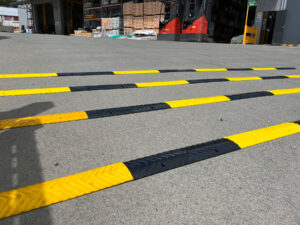

[fullwidth_text alt_background=”none” width=”1/1″ el_position=”first last”]
It has thus resulted in sustainability becoming the major focus area for road agencies. How can roads become an effective contributor to sustainable initiatives? And how can roads positively adapt to the growing challenges of climate change?
During the construction phase, it is important to determine the gas emissions of various materials and determine which construction process is the most environmentally friendly method. Materials commonly used for road surfaces range from aggregates to asphalt or concrete. Opting for materials that require less mining extraction, processing, and transportation methods will significantly reduce the overall gas emission during the construction phase. Greenhouse gas emissions from the construction of roads is one of the largest contributors to climate change, creating an estimated 22% of global carbon dioxide emissions.
Road agencies have begun to implement several sustainable practices such as the effective use of recycled materials, improving in-situ materials, and using industrial by-products. The question of How can we build roads that last longer and require less maintenance? is now the benchmark for best practice.
Several key risks have been identified. The roads agencies have deemed it essential to mitigate these risks in order to effectively combat the repercussions of climate change. Increases in road maintenance costs and shortages of aggregates are risks that can be alleviated by changing the surface material used. The increasing population results in a greater demand for transport infrastructure. With correct planning, roads can be designed to allow for these growing demands and therefore reduce the incurred costs of unexpected maintenance repairs.
It has been collectively agreed that the material used for the road surface has a direct impact on climate change. This has also been identified as the area where the most significant change can be made. Various countries around the world have already opted for alternative surface materials. Japan is currently the forerunner and the only country to have successfully implemented the use of recycled asphalt. Other countries are however currently conducting successful pilot programs. Australia has several pilot programs that include the use of recycled concrete asphalt, a foamed bitumen stabilisation process, and the use of recycled potable water. Greece has implemented the reuse of bauxite residue and New Zealand is using crushed glass aggregates.
Climate change is significantly impacting roads. The increased temperatures are causing many older road surfaces to easily crack. The age of some of these surfaces makes repair an almost impossible option, resulting in a full stretch of road needing to be replaced. This is both costly and time-consuming, and creates traffic congestion and route diversions. Temperature increases from climate change are causing established weather patterns to change, and creating an increase in extreme weather events such as flooding, storm surges, tropical cyclones, droughts, and heat waves. It is forecast that the average number of days in which the temperature exceeds 35˚C is expected to increase from 10% to 100% by 2030. Extreme weather events are severely damaging road surfaces as well as the surrounding paved surfaces and bridges.
In North America, Julie and Scott Brusaw have successfully implemented a new pilot program for solar panel road surfacing known as Solar Roadways. This initiative proposes the use of silicon solar cells and LED lighting embedded within the surface of the road. It aims to replace standard asphalt roads, parking spaces, pavements, and bike paths with advanced solar panels that generate clean and renewable power. The panels also contain heating elements to melt snow, inductive charging capabilities for electric vehicles, and storm water management abilities. The Brusaws say: “We started batting around the idea of replacing asphalt and concrete surfaces with solar panels that could be driven upon. We thought of the “black box” on airplanes: We didn’t know what material that black box was made of, but it seemed to be able to protect sensitive electronics from the worst of airline crashes.”
Their vision might seem impossible to achieve, but what if “Everyone has power. No more power shortages, no more roaming power outages, no more need to burn coal (50% of greenhouse gases). Less need for fossil fuels and less dependency upon foreign oil. Much less pollution. Internal combustion engines would become obsolete. Our dependency on oil would come to an abrupt end.” This would certainly be a huge step in the right direction.
Researchers at the University of Bath, Cardiff University and the University of Cambridge are working on a self-healing concrete that uses bacteria to seal cracks that can lead to decay and collapse. The aim is to create a concrete blend containing bacteria in microcapsules that will germinate if water seeps through a crack. The bacteria will produce limestone as they multiply, sealing the crack before the water can cause structural damage. Self-healing concrete could vastly increase the life of concrete structures, remove the need for repairs, and reduce the lifetime cost of a structure by up to 50%.
We will keep you updated on this ever-increasing concern of climate change and its significant ramifications. If the road agencies of the world are able to find successful initiatives that can preserve and protect the future of our roads while simultaneously combating climate change, we will definitely give them the green light of approval.
Source: http://www.sbenrc.com.au/wp-content/uploads/2013/11/sbenrc_1.3futureofroads-industryreport.pdf
[/fullwidth_text]



For 10 years, our focus has been on one thing: to provide one style of product and to do it well.
Our wheel stops, speed humps and rumble bars meet Australian Standards, don’t fade, and we’ve never needed to replace one.

For 10 years, our focus has been on one thing: to provide one style of product and to do it well.
Our wheel stops, speed humps and rumble bars meet Australian Standards, don’t fade, and we’ve never needed to replace one.